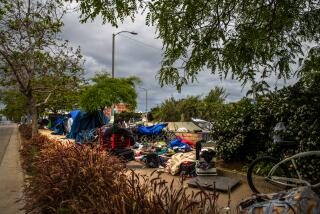Plan for Low-Income Housing a Tough Sell : Ventura: Homeowners say they’ve had enough. They’re fighting a nearby project with a petition signed by 700 residents.
- Share via
Ventura homeowner Bill Roderick has attended all the neighborhood meetings and engaged in extensive arguments with the developer, and he remains convinced.
Build houses and apartments for poor people on nearby farmland, and he can say goodby to his neighborhood as he knows it.
“In the Los Angeles area, everywhere they’ve put in low-income projects . . . the neighborhoods turn into ghettos,” Roderick said one afternoon last week, sitting in the immaculate living room of a house in the Heather Glen subdivision.
Many of the residents of Heather Glen--a well-tended 135-house community northeast of Wells Road and Carlos Street--have lived there for years. The first house went up in 1963, and the development was complete by 1970. The houses now range in price from $200,000 to $250,000, according to Sue Judd, an agent with Jon Douglas Co. Realtors.
In the late 1960s, mobile homes were built to the southwest, and 10 years later the first tenants moved into a new apartment complex to the southeast. An affordable-housing community is under construction to the northeast.
Now the Saticoy-based Cabrillo Economic Development Corp. wants to build about 140 low- and very-low-income houses and apartments between the existing apartments and the affordable-housing community. The new units will be targeted at families of four who earn $20,000 to $45,000 a year.
Heather Glen residents say they have had enough, and they are fighting back, armed with a petition signed by 700 residents who live within a mile of the proposed development. Let low-rent housing go up in someone else’s back yard, they say--as for Heather Glen, it has seen its share.
“We are what you call WAMBYs,” Roderick said. “Why-Always-in-My-Back-Yard? We would like the council to put it in their back yard, in Ondulando, in the Keys. It’s someone else’s turn.”
Homeowners in Heather Glen and nearby communities have landed on the front lines of Ventura’s battle to build more housing for the poor.
Although police and Cabrillo officials say the homeowners’ fears are largely unfounded, the homeowners worry that a low-income development will bring increased crime, snarled traffic and plummeting housing values.
But whatever the residents’ objections, federal law obligates the city to construct a certain amount of low- and very-low-income housing, and the proposal by Cabrillo would make a dent in that mandate.
As of the first of this year, Ventura was 638 units short of the low-income requirement and 496 units short of the very-low-income requirement.
It is not clear what the consequences will be if the city continues to fall short of these goals, city officials say. No laws exist to mete out punitive measures for such transgressions, but the city does risk the possibility of a lawsuit by civic activists, officials say.
Officially, a portion of Ventura’s 900 housing allocations downtown are supposed to be set aside for inexpensive housing. But council members say they hope to target those units for moderately priced housing to help revitalize the business community in the area.
“I think we need to get our low-income housing inventory up in other parts of the city,” said Councilman Gregory L. Carson, specifying the eastern Ventura suburbs as one area to locate the lesser-priced units.
As dictated by federal law, Ventura has designated a local developer to receive its Housing and Urban Development Department funds and has told that developer, Cabrillo, to find land on which to build.
Cabrillo executives chose 23 acres at the end of Citrus Drive and came up with a plan that includes a day-care center, a community center, and, tentatively, 80 houses and 58 apartments. The housing would sell for about $100,000 to $120,000, and the three- and four-bedroom apartments would rent for $600 to $700 a month, Cabrillo officials said.
The council already has promised Cabrillo the city’s 1993 HUD funds, totaling about $284,000, and tentatively has pledged the 1994 sum of about $345,000 toward construction of a low- and very-low-income project somewhere in the city.
Altogether over the next few years, Cabrillo officials say, they hope to receive about $1.4 million in HUD money from Ventura, which they would leverage to raise the additional $23.6 million they need for the Citrus Drive project.
That is, if the development wins City Council approval, a step by no means certain.
“It’s going to be an uphill challenge,” said Everett Millais, Ventura’s director of community services, “because of the vociferousness of the opposition.”
Opponents began organizing last spring on the eve of a meeting in which the council was to consider giving conceptual approval to the Cabrillo project. When council members realized how uneasy neighbors were about the project, they refrained from taking any action and ordered Cabrillo officials to meet with residents.
Since then, the residents and developer have held five meetings. Neither side emerged very happy.
“I think they have been rather close-minded about the whole thing,” said Rodney Fernandez, Cabrillo’s executive director. “They never opened their minds to negotiating this in good faith.”
The Heather Glen activists, for their part, believe the Cabrillo officials are underhanded and secretive.
“They have not told us the truth from the start,” said resident Julia Millsap, who is spearheading the petition drive and the opposition effort. “They give us inadequate answers or they won’t answer us at all.”
Roderick said he asked Cabrillo for addresses of its other single-family developments, and that Cabrillo refused to provide them. Fernandez denies the accusation.
The problem is that the two sides cannot agree on a basic premise--should the project exist at all near Heather Glen?
Neighbors lobbying against the development believe it should not. When their development was approved, they never expected to end up surrounded by lower-priced housing.
Cabrillo officials say they will negotiate the project’s layout and its proportion of houses to apartment units. But they have a five-year purchase option on the property, and say they plan to build if the council approves the development.
Many of the residents’ fears concern crime, which they say is escalating in their once-quiet neighborhood.
Resident Anne Cormode’s car was broken into three times in the past two years. Millsap fears the neighborhood so much that she now walks the area, even in the daytime, with a gadget in her hand that sounds a piercing scream at the push of a button.
Ventura police, however, say the neighborhood is not especially dangerous. “It’s probably one of our higher locations for calls for service, but that’s not to say it’s a constant problem,” said Lt. Steve Bowman, a spokesman for the Ventura Police Department.
Bowman added that just because a development houses low-income residents does not mean it is a hot spot for criminals. In the 1970s, he said, homeowners near Petit Avenue and Telegraph Road raised a furor over a low-income housing project planned for that area, citing many of the same objections the Heather Glen residents list today. None of the concerns materialized, he said, and the complex remains quiet.
“They are never the problem people say they will be,” he said. “Property values never suffer dramatically and crime never rises dramatically.”
That has proved true of two other Cabrillo developments built in Fillmore and Ojai. Although neighbors strongly objected to both projects when they were proposed, police in Fillmore and Ojai say the complexes have been quiet.
But Heather Glen residents say they do not want to take the chance that this Cabrillo project will be the exception.
“We are going to be accused of being a bunch of rednecks,” homeowner Dick Harp said. “But there’s got to be a better solution than what they are proposing.”
More to Read
Sign up for Essential California
The most important California stories and recommendations in your inbox every morning.
You may occasionally receive promotional content from the Los Angeles Times.






